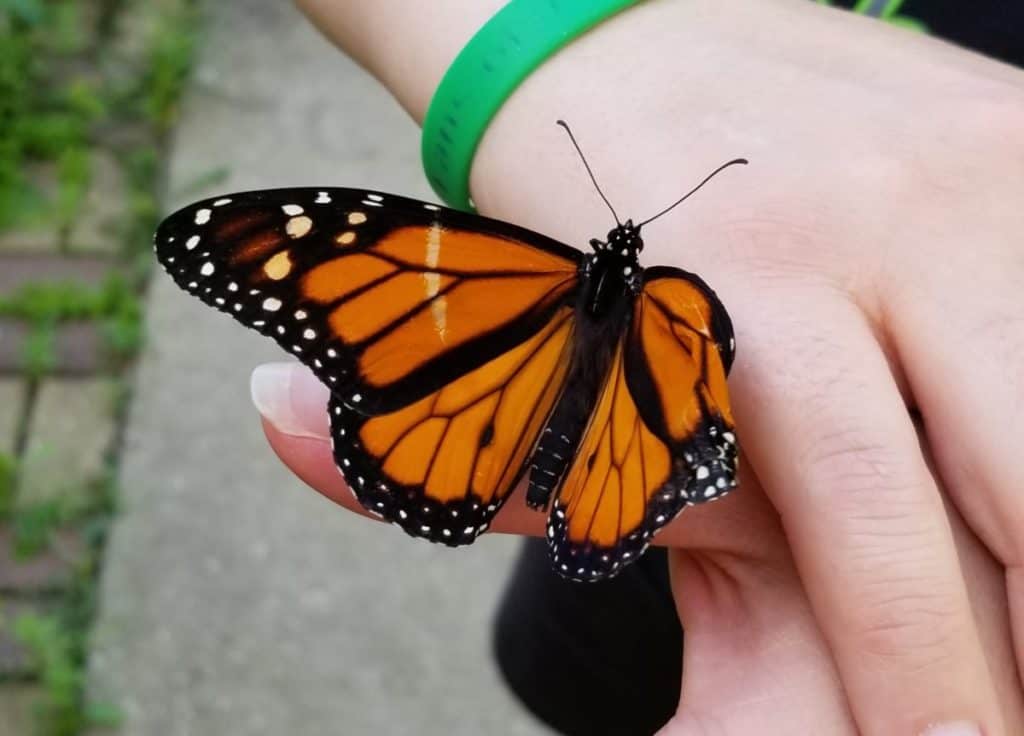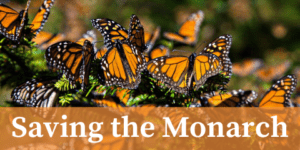
Growing up in the Midwest of the United States in the 1980s, I remember seeing Monarch Butterflies everywhere during the summer when I was a kid. It wasn’t until after I started hearing and reading the news stories abound the significant decline in the Monarch population that I realized that they weren’t around as much as they were when I was younger. So I set out to see what I could do to help save the Monarch.
So how can you help save the Monarch?
The short answer:
- Plant milkweed – this is the only plant that Monarch caterpillars can eat
- Plant native flowers – Monarch butterflies need nectar from flowers as their food source
It’s as simple as that. Monarchs really just need those 2 things to survive. So in order to help save the Monarch, you need to plant milkweed for the caterpillars and flowers for the adult butterflies. But, because both of those things are plants, the types of milkweed and flowers you choose for your garden is highly dependent on where you live. So it is not really that simple. Lets dive a little deeper so you can pick out the best plants for your area.
Hardiness Zones
If you are new to gardening (or even if you’re not), the first thing you need to figure out before picking out plants for your garden is to figure out which hardiness zone you live in. When you shop for plants or seeds, there should be a hardiness zone listed on the label. In simple terms, a hardiness zone is a way to easily identify if the plant will be able to survive winter in a particular area.
The United States Department of Agriculture (USDA) has an interactive map where you can easily find which zone you live in. Clicking this link will open up the USDA Hardiness Zone Map in a new browser tab. Hardiness zones are based on the average annual extreme minimum temperature between a range of years. As you can see from the Hardiness Zone Map, there are a total of 26 zones specified, ranging from 1a to 13b. The lower the hardiness zone number, the more cold tolerant a plant is. For example, a plant with a hardiness zone rating of 5b (where I live), should be able to survive temperatures down to -15° Fahrenheit. A plant with a 3a hardiness zone label on it should be able to survive temps down to -40° Fahrenheit.
A couple of important things to note regarding hardiness zones. The zones are based on the “average annual extreme minimum temperature”. Average is the keyword here. If you have a particularly brutal winter where temperatures get below that average, the plants may not survive even though they are rated for your hardiness zone. Also note that if you find a plant that you particularly love, but it has a hardiness zone rating higher than the zone you live in, it doesn’t mean that you can’t plant it in the garden. It just means that it probably won’t make it though the winter. So instead of being a perennial plant, it will be an annual.
Perennial vs. Annual vs. Biennial
There are 3 main types of plants. A perennial is a plant that you can plant one year and it will come back the next year, and the year after that, and the year after that. Of course, this depends on if the plant is hardy for the zone you live in and that the winter isn’t too much colder than average. I usually plan perennials in our butterfly garden; plant them once and you’re done for years to come. Perennials often don’t bloom their first year. Many perennials spend most of their energy during the first year building their root system. And because they are using most of their energy for their roots, they don’t have any energy left to produce flowers.
Annuals live for 1 year and then die. While the perennial plant spends its first year on its roots, the annual spends its energy on the stuff you can see…the flowers. Once the annual plant stops producing flowers, it will start to die off. Some annuals will produce seed when the blooms start to die. If you like a particular annual and it “goes to seed”, you can collect the seeds, save them, and plant the seeds next year. Sometimes you don’t even need to collect the seeds. Self-sowing annuals (or reseeding annuals) will drop their seeds to the ground and sprout the following spring. One note of caution on this. They do have a tendency of sprouting up where you don’t want them. When we first started our butterfly garden, we decided to do it the “easy way”. We bought a box of “butterfly and hummingbird garden mix” from our local garden center and sprinkled it in the garden. One of the flowers in the mix was Cosmos Sensation. The following year we found the Cosmos growing in random spots. Some were growing on the other side of the house. It stumped me for a little bit, but I think that a bird must have eaten some of the seeds that the plant produced as it was dying and pooped them out as it was flying away. If I piqued your interest when I mentioned the “butterfly and hummingbird mix”, I will tell you my thoughts in more detail below.
Biennial plants are somewhere between annuals and perennials. They spend their first year on their roots, just like perennials. They will produce flowers in their 2nd year, and then die. Some biennial flowers will “go to seed” when they die. This just means that when the flowers fade and wilt, the plants start to produce seeds. If left alone, these seeds will eventually drop out of the plant, and assuming at least some of the seeds make contact with the soil, the seeds will sprout the following year, and the process will start over again.
Butterfly Seed Mixes
Hardiness zones? Annuals? Perrenials? Biennials? Are you starting to think this is too confusing? Wishing you could just buy a magical box of seeds, sprinkle them in the garden, water them, and voila, a butterfly garden? Well, it actually can be that easy. I am not sure that I would recommend it, though. When we first started our butterfly garden, we bought a Butterfly & Hummingbird Mix (Amazon link will open in new tab). While we did have a bunch of butterflies and hummingbirds in the garden that year, it grew a little bit out of control. While there were lots of pretty flowers, it was also full of weeds. I don’t know if there were weed seeds in the mix, or if they were in the soil that we added to the garden. And even though we had an idea of what flowers were in the mix, when you have a bunch of green sprouts, it is hard to tell which are going to be flowers and which ones were weeds. The mix we used (and I think all “butterfly garden” mixes are) was all annual seeds, but I am still finding Chinese forget-me-not flowers 2 years later. I think I know how this flower got its name. This is one of those annuals that reseeds itself and comes back the next year. For the past 3 years I have been trying to pull them before they go to seed, but they just keep coming back! And I know if I give up and stop pulling them, they will be worse the next year, and even worse the year after that.
The other problem I had with the Butterfly & Hummingbird mix was that we couldn’t place the plants where we wanted them. I admit that I am a bit OCD and like to have things just right. We did get lots of compliments from our neighbors, but to me it was kind of unsightly. And because the garden is in the front yard, I was almost embarrassed by how it looked. The following spring, we yanked everything out and started over again…with carefully chosen perennials.
If you do want to try a mix of seeds, I would recommend starting with a small area to see how you like it. You might have better luck than we did. But also remember that the flowers in most (if not all) of these mixes are annuals. They will only live 1 year and then die. Then you will have to remove the dead plants and sprinkle more seed the following year. I am more of a do it once kind of guy, so the following spring we yanked everything out, and planted perennial seeds. I know, we could have bought plants, but we would have spent hundreds of dollars to fill our garden with plants. It was much more economical to buy seeds.
One last note. Butterfly seed mixes do not include milkweed. Remember the two things we need to save the Monarchs? Nectar (flowers) AND milkweed. The flowers in the butterfly mix might give the butterflies something to drink, but without the milkweed, the female Monarchs won’t have anywhere to lay their eggs. And if they don’t lay their eggs, we won’t have Monarch caterpillars which will eventually turn into butterflies.
Location, Location, Location
Have you ever heard the saying that “the three most important things in real estate are location, location, location”? Well, the same is true for a butterfly garden. The majority of plants that are perfect for a butterfly garden require full sun. By “full sun”, we mean 6+ hours of sun per day. This is why are butterfly garden in in our front yard…it was the only spot that gets enough sun throughout the day. Butterflies also need sun. They are cold-blooded and they need the heat of the sun in order to fly. Have you ever seen a butterfly perched on something in the sun with its wings open? It’s warming up its muscles so that it can fly. Butterflies are cold-blooded and they generally need an air temperature of 60 degrees Fahrenheit (15.5 degrees Celsius) to fly.
Okay, So What Kind of Plants Should I Put in My Butterfly Garden?
Without knowing where you live, this is next to impossible to answer. Remember the “Hardiness Zones” section above? If you live in the upper Midwest of the US like I do, your plant selection will be different than somebody that lives in the southern US. My goal with this website is to do my best to provide the best possible information for anybody that comes to this site, although my main focus will be North America. I have already written a couple of articles on milkweed, which I will have links for below. As I add additional articles, I will add those links below as well.
Which Milkweed is Best for Monarchs?
